

Rare is the Palestinian meal that does not include a salad. Whether served as an accompaniment to a main dish or as part of an array of mezze, Gaza’s salads are notable for their vibrant flavors and brilliant colors.
Dagga (Salata Ghazawiyya) • Gazan Hot Tomato and Dill Salad
Salatit Abu Safiya • Abu Safiya’s Salad
Salata Khadra Mafrooma • Gaza “Confetti” Salad
Abdel Munim Ahmed and the Gaza Safe Agriculture Society
Salatit Beit Jirja • Beit Jirja Salad
Salatit Jarjir • Arugula Salad
El-Manar Tahina Factory, Zeitun
Salatit T’heena • Tahina Herb Salad
Mareesa • Kishik and Hot Pepper Dip
Salatit Kishik u Bandora Meshwiya • Charred Tomatoes and Kishik
Salata Milaaha/Fatt Malaahi • Sailors’ Salad
Salatit Batata • Garlicky Potato Salad
Serves 2–3
½ teaspoon salt
2 cloves garlic, peeled
2 to 3 hot green chile peppers (to taste), coarsely chopped
¼ cup (10 grams) finely chopped fresh dill
3 ripe, flavorful medium-sized tomatoes, coarsely chopped
2 tablespoons high-quality extra-virgin olive oil
Using a mortar and pestle, mash the garlic and salt into a paste. Add the chile peppers and crush until they are tender, followed by the dill. Using a circular motion, gently muddle the dill until fragrant. Add roughly chopped tomatoes and pound until the salad reaches a thick, salsa-like consistency. Mix the entire salad with a spoon, then drench it with extra-virgin olive oil. Serve with Khubz Kmaj (page 100) on the side for scooping it up.
Variation
Substitute 1 tablespoon of dill seeds for the fresh dill and 2 tablespoons of finely chopped or grated onions for the garlic. The dill seeds should be ground thoroughly in the mortar in a circular motion, along with some salt, before adding the onions. Finish the dagga with a squeeze of fresh lemon. Top generously with olive oil.

This is the most basic and most frequently served salad in Gaza, with a hot bite that makes it a fantastic accompaniment to meaty stews or rice dishes. Dagga, which is a variation of the word meaning “pounded” in Arabic (an irony that is not lost on Gaza’s inhabitants), is commonly scooped up with Arabic bread and has a consistency similar to that of a Mexican salsa.
As with many other recipes in this book, there are hotly contested variations. Many friends and family members insist that authentic dagga should only be prepared with dill seeds and onions, while others argue that fresh dill and garlic are the essential components and that the color should be greener than it is red. While the origin of these elemental allegiances remains a mystery for the ages, one thing is clear: Dagga, no matter how it is prepared, is always a winner, “the centerpiece of the Gazan dinner table” as Laila’s late maternal grandmother used to put it. Here, we include the recipe Laila grew up with.

Serves 2–3
½ teaspoon coarse sea salt
1 tablespoon dill seeds
3 cloves garlic
2 to 3 hot green chile peppers, chopped
1 shallot, finely diced
2 tablespoons chopped green onions
½ cup (12 grams) finely chopped herbs (any combination of fresh parsley, mint, dill, cilantro, or basil)
3 very ripe, flavorful tomatoes, chopped
Juice of one large lemon
2 tablespoons tahina
Extra-virgin olive oil
In a mortar and pestle, roughly grind the dill seeds along with the salt, using strong circular motions, until fragrant. Add the garlic and mash it to a smooth paste. Next add the chiles, green onions, and shallots and crush well. Add the herbs, muddling with the rest of the ingredients until well incorporated. Stir in the chopped tomatoes and mash until a salsa-like consistency is achieved.
In a separate bowl, whisk together the lemon juice and tahina until they are emulsified, then mix this into the salad. Flatten the top of the salad, then finish it with a generous drizzle of olive oil on top. Serve with Khubz Kmaj (page 100).

Yousef Abu Safiya is the former minister of the environment. He is also a zealous ecologist, amateur nutritionist, innovative cook, and tinkerer. Eager to tell us about his adventures in the kitchen, he shared this recipe for a cousin of dagga that has been in his family for generations, since before they fled to Gaza for safety from the village of Hamama in 1948. He makes it, with great pride, in the same twenty-seven-year-old zibdiya his father used.
“We ate this salad for any meal of the day, even for breakfast, particularly in the 1950s and 1960s when we refugees didn’t have much else. Most of the time it was made without the herbs, sesame paste, and olive oil, which were too pricey.”
Serves 4–6
3 firm, flavorful tomatoes
4 Middle Eastern cucumbers, or 1 English cucumber, peeled
1 bunch green onions
1 yellow bell pepper
1 orange bell pepper
3 green chile peppers (to taste), seeds removed
¼ small head red cabbage
1 bunch fresh mint, leaves picked
1 bunch fresh parsley, thick stems removed
1 garlic clove
Rind of one lemon, finely chopped
½ teaspoon salt
¼ teaspoon fresh black pepper
Juice of 2 lemons
3 tablespoons extra-virgin olive oil
Finely chop the tomatoes, cucumbers, onions, peppers, and cabbage into equally sized small bits. Toss them together in a bowl. Wash and towel-dry the herbs well, chop to a medium-coarse consistency, and add them to the mix.
Mash the garlic to a paste with a ¼ teaspoon of the salt using a mortar and pestle. Stir the garlic, along with the lemon rind, into the salad.
Just before serving, season the salad with the remaining salt and the pepper. Drizzle with lemon juice, followed by olive oil. Toss to combine. Adjust the dressing to taste: the salad should not be soggy.
Serve with rice-based main dishes such as maqlooba or qidra, or with stews (tabeekh).
Variations

This bright and spicy salad is often served alongside maqlooba or other similar rice dishes. The dedication of the cook is revealed by how finely she chops her vegetables.

Every once in a while, you meet someone who is absolutely radiant with conviction, pleased with his work and the place he has made in this world. Abdel Munim Ahmed, co-founder of the Gaza Safe Agriculture Society in Beit Hanoun, is one of these people. He shows us around the Society’s tiny organic model farm, gleefully explaining the ingenious harmony of birds and beneficial insects that keep the farm free of pests. “We send them written invitations,” he says, pointing to a ladybug. “Of course, whenever they find any place without vicious pesticides, they come inhabit this niche, produce eggs, and multiply. Whenever you apply something poisonous, this repels everyone, even people. It’s a very simple idea. The ideas here are very simple ones.”
Abdel Munim founded the Society in 2001, when he returned to Gaza after studying landscape architecture in Egypt and organic farming methods in Italy. Initially, the idea was to provide technical support to farmers interested in applying organic techniques. Local farmers were interested, but didn’t feel they could take any risks and stuck to using pesticides. In 2005 the Society began a demonstration farm to show that organic methods really would work.
At first the farm covered seven hectares (about seventeen acres), producing more than enough to supply an all-organic store in Gaza City. But when the siege began in 2008, fuel prices skyrocketed and they could no longer pump water for irrigation nor get their products to market. Like so many of their neighbors, they had to reduce the land under cultivation radically. Now the farm is less than one hectare (about two and a half acres): a verdant oasis climbing with garden vegetables, aromatic herbs, and a fishpond for collecting winter rainwater.
Most of the Society’s business now comes from local consumers, who come to the farm to purchase pesticide-free produce.
As for spreading the gospel of organic farming, many of the neighboring farmers admire the work the Society does and have adopted some of the organic techniques. For several months the siege blocked access to all chemical fertilizers, and there was a surge of interest in the organic compost that the Society produces. But now fertilizers and pesticides are entering the Strip again on a limited basis.
Many farmers acknowledge that compost helps retain groundwater better than chemical fertilizers and that pesticides represent a futile race against increasingly resistant infestations. Even so, their economic needs are immediate, and without ongoing support, they cannot begin to make the slow transition to organic methods. Moreover, as the whole border area has been stripped of all tree cover in successive Israeli incursions, it becomes harder and harder for beneficial birds and insects to find their way across that wasteland to whatever little piece of land is hospitable to them. As Abdel Munim explains:
This is a small place to be a habitat for such a number of birds and bugs. We lost a lot of beneficial insects with the war. Especially when big trees were destroyed. Can you imagine a big tree like this one, how many birds and insects are living in it? It is a skyscraper for beneficial insects. And when a bulldozer comes and eliminates this tree, of course the ecological balance is destroyed. Can you imagine the buffer zone, the whole eastern part, totally destroyed? You cannot find any living thing there now. And it is not only the birds and insects, but also the land through erosion.
It is no surprise, then, that many farmers overuse pesticides: With all means of natural pest control annihilated, how else are they to produce enough to stay afloat, especially when they’ve lost acres of land to the buffer zone? This phenomenon has only increased since 2010, with recent spraying of broad-spectrum herbicides throughout the Israeli-imposed “no-go zone” and further razing of all vegetation in the area.
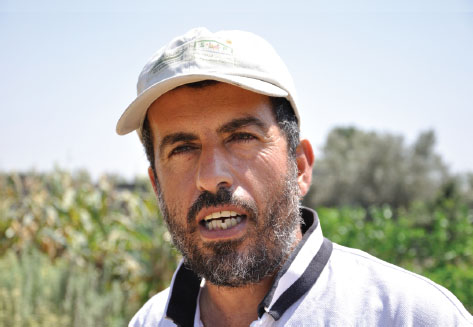
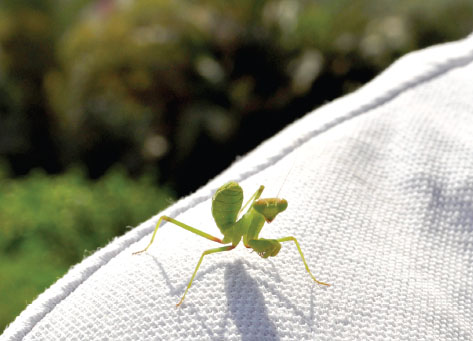
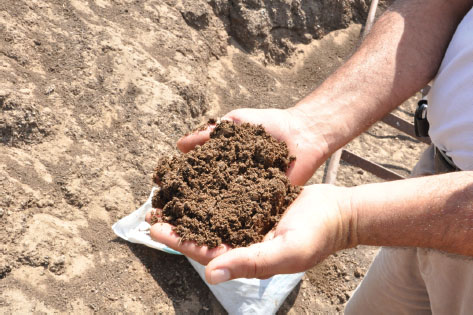
Serves 2–3
½ tablespoon dill seeds or ¼ cup (5 grams) fresh green dill
1 garlic clove
2 hot green chiles (to taste)
3 ripe tomatoes, chopped
Juice of a half a lemon
1 small Middle Eastern cucumber or half a hothouse cucumber, finely chopped
¼ packed cup (5 grams) of parsley, finely chopped
1 tablespoon red tahina or 1 tablespoon regular tahina mixed with ¼ teaspoon toasted sesame oil
Extra-virgin olive oil
Salt to taste
Grind the dill seeds with ½ teaspoon salt in a mortar and pestle until fragrant, or else muddle the finely chopped fresh dill. Add the garlic, mashing well, followed by the chilies. Crush well.
Add the tomatoes and lemon juice and pound slightly until just incorporated.
Stir in the finely chopped cucumbers and parsley. Mix in the tahina until it is uniformly spread. Adjust salt to taste. Flatten the top of the salad, and drizzle generously with olive oil. Serve with Khubz Kmaj (page 100).

Salatit Beit Jirja is typical fare from a village—now disappeared—that was just north of the present-day Gaza Strip. For the many refugees in Gaza originally from the Beit Jirja area, this is the basic salad that accompanies most meals.
Serves 2–3
1 small onion, thinly julienned
1 bunch arugula (approximately 2 to 3 cups, or 60 grams), coarsely chopped
2 tomatoes, finely chopped
Juice of 1 lemon
Salt and pepper to taste
Extra-virgin olive oil
Rub the julienned onion with the salt and pepper. Toss with the chopped arugula and tomatoes. Season with olive oil and lemon juice.

Peppery arugula (also called rocket) is one of the most common greens in Palestine and is particularly popular in Gaza and neighboring Egypt. The leaves are often served whole with white cheese and other mezze for supper, or chopped into a simple salad, like this one.

The sliding metal door of the El-Manar Factory opens to reveal a large aluminum warehouse with rows of hoary steel machines humming and grinding, making one of Gaza’s best-known brands of tahina. Sacks of sesame seeds are piled at one end of the factory, and the finished product waits in plastic tubs for distribution on the other end.
Twenty-year-old Yusuf Al-Dirawi, who works here at his family’s factory while finishing his university degree, hurries over to show us around.
The raw sesame seeds come from various countries: India, Somalia, Sudan. For the moment, Yusuf says, there is no problem getting them in through the Israeli border, although in the past years there have been periods when this was impossible and the sacks of sesame had to enter through the tunnels, driving the prices through the roof.
The seeds are first soaked until the skin comes off, then rinsed several times and drained. They are then transferred to one of two different roasting machines: one that roasts with steam heat, for making the “normal” kind of tahina known all over the Middle East, and the other that roasts with direct heat, toasting the seeds to make Gaza’s own particular “red tahina,” which has a nuttier, richer sesame taste.
Once roasted, the seeds are ground “the old way,” between two great millstones, which Yusuf says produces a better taste than any of the modern machines they’ve tried over the years. After milling, the paste is bottled for local distribution.
El-Manar does not export; none of the nine small-scale tahina factories still operating in Gaza do. Even if Israel did not ban nearly all exports from Gaza, they could not compete with tahina made elsewhere, due to the exorbitant price of importing the raw material—sesame seeds—into Gaza. Ninety percent of the factories active in Gaza before 2007 have already gone under due to this impossible balance of trade. Like all the other manufacturers that have survived, the owners and workers of the El-Manar factory watch the borders anxiously. At the time of our visit, Israel was allowing some manufactured goods (like tahina) to enter the Strip, where they competed with local products. At the same time it was limiting the entry of raw materials (like sesame seeds), meaning higher operating costs and a smaller market for manufacturers. It wasn’t clear, Yusuf said, whether the family business would survive.

As of 2016, Israel has begun to allow some manufacturers from Gaza to market their goods in the West Bank. It remains to be seen if this window of opportunity will be sufficient to keep these companies on their feet.
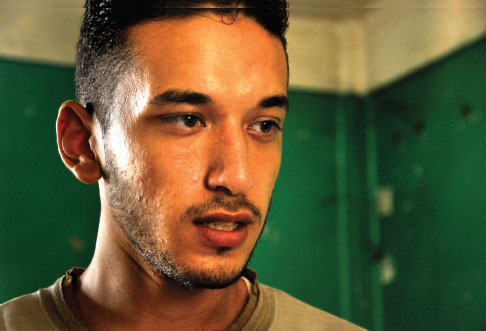
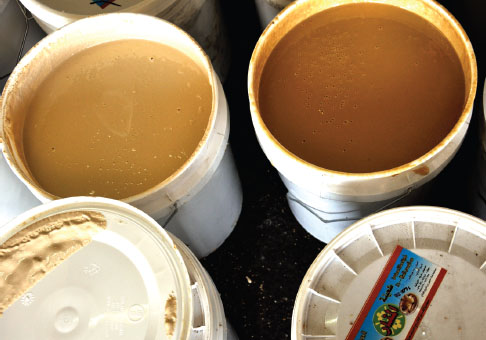
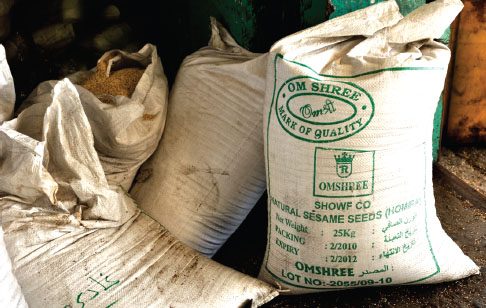
Serves 3–4
1 medium tomato
½ cup (12 grams) finely chopped dill or parsley
1 quantity Salsit T’heena (page 30)
Finely chop and de-seed the tomato. Gently stir the chopped tomato along with the herbs into the prepared salsit t’heena. Transfer to a small flat bowl and garnish with fronds of dill or parsley. Serve accompanied with warm Khubz Kmaj (page 100).

Though delicious on its own scooped up with Arabic bread, this salad is commonly served alongside fried fish or sayadiyya (page 280).
Serves 2–3
1 round of hard kishik or 3 tablespoons powdered or 5 tablespoons liquid kishik
½ teaspoon salt
1 teaspoon dill seeds (optional)
2 hot green chile peppers, chopped
Juice of one lemon
Olive oil
If the kishik is hard, break it into small pieces and moisten with a few spoonfuls of water. Allow it to absorb the liquid for a few minutes, and then pulverize it in a food processor or blender or by hand in a mortar and pestle until a paste, similar in consistency to hummus, is achieved. (If you are using powdered kishik, moisten with water as above and mix by hand. If you are using liquid kishik, skip this step.)
In a mortar and pestle, crush the dill seeds with salt, using a strong circular motion, until fragrant. Add the peppers and pound until soft. Stir in the lemon juice and mix well.
Add the kishik paste and stir. If the mixture appears too thick, add a bit of water or more lemon juice until the consistency is that of a dip. Spread it out in a small flat or oblong serving platter and drizzle it with olive oil. Serve with Khubz Kmaj (page 100).

Check Middle Eastern markets for kishik or make your own (see page 42). In southern Gaza, each town or region has its own way of using this traditional fermented dairy product; we have included two here.
Serves 2–3
1 round of kishik (page 42) or 3 tablespoons powdered or 5 tablespoons liquid kishik
7 cherry tomatoes or 4 to 5 small tomatoes
¼ teaspoon salt
2 cloves garlic
1 tablespoon olive oil
1 tablespoon chopped fresh dill
Moisten and crush the kishik as described in the previous recipe. If you are using powdered kishik, mix it with about 5 tablespoons of water until a smooth, thin paste forms. If you are using liquid kishik, you may skip this step.
Pierce the skins of the tomatoes and broil them in an oven until limp (you can also skewer them and roast them over a gas burner or grill). Allow to cool, then peel and transfer to a serving plate.
In a mortar and pestle, crush the garlic and salt until smooth. Add oil and mix well. Meanwhile, crush the tomatoes gently with a fork, so they don’t totally lose their form. Drizzle the liquefied kishik on top, then sprinkle with the chopped dill. On top of this, spread the garlic-and-oil mixture. Serve with Khubz Kmaj (page 100).

This kishik salad is typical of Garara, an agricultural region in the central part of the Gaza Strip.
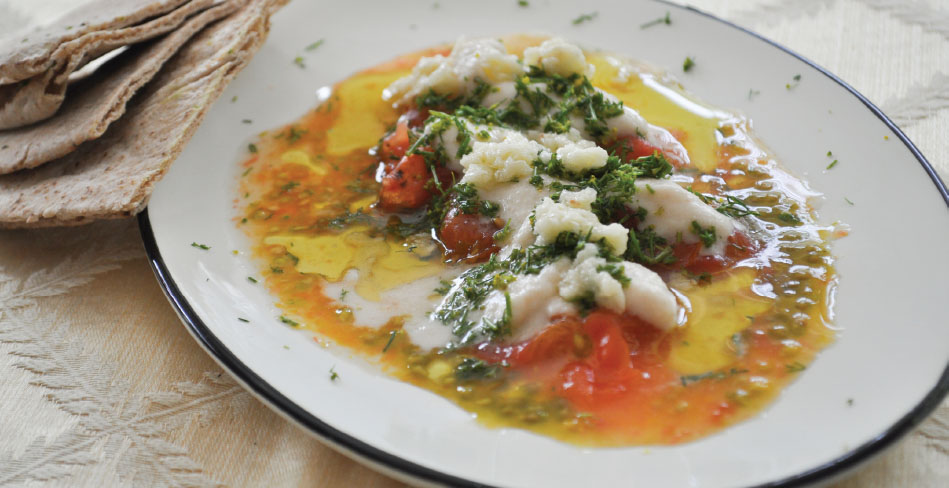
Samira Hamdan shows up to do her shopping at the Gaza Safe Agriculture Society Farm in Beit Hanoun while we are interviewing the farmers. She jokes and laughs with them while she selects her vegetables, and her kids run off to play with theirs: She is clearly a regular client. We ask her why she shops at the farm, and she explains that she had started to notice lots of people getting sick for no reason and wondered why. She herself survived breast cancer after a mastectomy, and when two of her kids fell terribly ill to watermelon poisoning—a very common problem in Gaza—she decided something was not right. She asked around and came across the organic farm, not far from her home. “I love this place,” she says, as her kids romp among piles of pumpkins. “We eat these vegetables and we know what is in them, we know they are good for us, not like others.”
Unfortunately, eating quality organic products is no guarantee of health in Gaza. The uncontrolled use of pesticides that once entered through the tunnels to circumvent the Israeli blockade—some of which have been banned internationally due to their high toxicity—is just one of many sources of environmental illness in the territory. The depleted uranium, white phosphorus, and harmful metals present in the weapons used in repeated Israeli attacks on the territory have left the soil dangerously contaminated. Moreover, many families are rebuilding damaged homes with recycled rubble, meaning that the toxic metals and radioactive waste found at impact sites come to form part of their everyday living spaces. The consequences—in terms of birth defects and the proliferation of cancers—have yet to be fully measured, though studies have begun to demonstrate clear correlations.
Samira Hamdan shakes her head. “Everything here is poisoned. But we have to eat, we have to breathe air and drink water…. All we can do is try the best we can to stay safe and pray to God to protect us.” Then, grinning, she hoists up her heaping bag of fresh greens, whistles to her boys, and heads home.
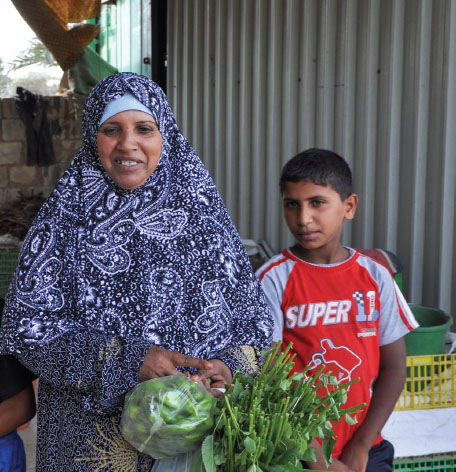
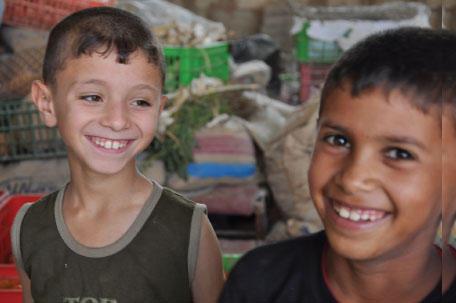
Serves 3–4
1 small round of day-old Arabic bread, toasted (see Khubz Kmaj, page 100)
½ teaspoon salt
2 to 3 hot green chile peppers, to taste
1 packed cup (about 25 grams) fresh basil, torn
4 green onions, finely chopped
2 Middle Eastern cucumbers or half a hothouse cucumber, finely chopped
3 medium-sized tomatoes, finely chopped
¼ cup (60 milliliters) red tahina or regular tahina whisked well with 1 teaspoon dark sesame oil
Juice of 2 medium lemons
Radishes, pitted green olives, and pickled peppers, to garnish
Break the toasted bread into small pieces. Set aside.
Chop the chile peppers, removing some of the membranes and seeds if you prefer less heat. With a mortar and pestle, pound the peppers along with the salt until soft. Add the basil and muddle in a circular motion to extract the flavor. Add the green onions and crush well, followed by the cucumbers. Finally, stir in the tomatoes and mash. Mix the entire salad to incorporate all ingredients.
In a separate bowl, whisk the tahina with the lemon juice until it is emulsified. Immediately before serving (not earlier, or the bread will get soggy), mix the tahina sauce and bread pieces into the salad. The juices from the tomato will thin out the tahina and soak into the bread. Transfer to a serving dish and flatten the top. Drizzle the surface of the salad generously with olive oil.
To finish, garnish with pitted green olives, pickled peppers, and radish slices.

Basema Abu Daff and her son Sami Zaharna, Gazans living in the United States, explain that sailors (milahee) would make this salad when they didn’t have much on hand except hard bread. “They would mix it with tahina and anything else in season, such as tomatoes, cucumbers, or basil. Ya salaam!” explained Sami, an engineer, part-time imam, and self-described “fatt malaahi evangelist.” Basema showed Laila how to make the irresistible salad at her brother-in-law’s house in Edgewater, Maryland.
Another source in Gaza City, Refaat Alareer, reports that “the best thing about it is that, according to my grandma, all the farmers would bring whatever they had available, put it in the mix, and eat it together, always with their hands. And of course olive oil! It was like the second most important ritual after prayer.”

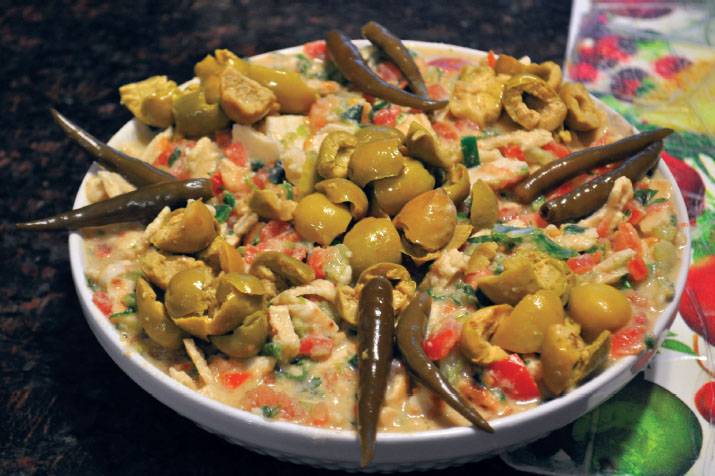
Serves 2–3
1 pound (500 grams) new potatoes
Olive oil
Salt and black pepper
½ quantity Daggit Toma u Lamoun (page 28)
2 tablespoons red tahina or 2 tablespoons regular tahina whisked thoroughly with 1 teaspoon toasted sesame oil
Wash and scrub the potatoes well, leaving the skins on. Cut them into halves or quarters. Boil them until they are just tender, drain well, then pan-fry or sauté them in a little olive oil until they turn golden. Alternately, you may oven-roast the potatoes with some olive oil.
Season the cooked potatoes with salt and black pepper. Transfer them to a serving platter, then dress them with garlic and lemon dressing and drizzle with the tahina.
Variation
Boil 1 pound (500 grams) baking potatoes with skins until tender; cool and peel, then mash well or press through a food mill. Add Daggit Toma u Lamoun (page 28), salt, and red tahina. Mix well and serve.

A very Gazan twist on the potato salad; makes a great picnic food.
Of all the terrifying aspects of life in Gaza, perhaps the most ominous of all is the water crisis. Less visible than the repeated assaults, less likely to make headlines than the political impasse, the depletion of Gaza’s aquifer is an inexorable countdown that threatens every single one of the territory’s 1.8 million inhabitants. Not in some remote future—now.
In 2013, the UN issued a report affirming that by 2016 there would be no more potable water in Gaza, and that by 2020 damage to the aquifer would be irreversible. That was before the 2014 assault left 80 percent of the territory’s water networks destroyed and its damaged sanitation network leaking raw sewage into farmland and the sea. More than a hundred thousand people don’t have running water at all; those who are connected usually have water in their taps for just a few hours every three or four days. The water they receive is, by all international standards, undrinkable. Those who can afford to pay for privately distributed drinking water often spend up to a third of their family income on water alone.
How has it gotten to this point? The dice were loaded from the start: Israel uses the vast majority of the water from the Mountain Aquifer—in principle shared by Israel and Palestine—as well as the surface water of the Jordan River and does not allow the transfer of any of this water to Gaza, even though the West Bank and Gaza are formally considered a single entity. The Israeli military, in fact, granted itself authority in 1967 over all water-related issues in the occupied territories. In tune with this, it diverts most of the surface water, which flows from the Hebron Mountains into Wadi Gaza, into a reservoir just before this water reaches Gaza. The result: While Israel has a water surplus, Palestinians are resorting to over-extraction, drilling, and other unregulated means to slake their thirst.
Thus Israel holds the water—an absolutely key element of survival in the region—and uses it as a bargaining chip in its relations with the Palestinians. In 2015, Israel began to fulfill an obligation acquired in the Oslo II Agreements (in 1995!) to pump water into Gaza, but just months before, it had bombed the reservoir intended to hold this water. Since the 2014 bombings, the various infrastructures needed for water storage and distribution have been so severely damaged that a significant percentage of the precious stuff is lost or contaminated along the way. Municipal workers race around madly trying to patch, mend, and redirect these leaky pipes.
Plans to ensure more sustainable access to water—and make that access less subject to Israeli political whims—are not lacking: There are plans for desalination plants, rainwater catchment, wastewater treatment and recycling, and so on. Critics argue that Gaza doesn’t need radical solutions, only equitable distribution. Until this happens, such plans could give the aquifer a needed rest and allow it to regenerate. But any of these plans, like the urgently necessary overhaul of the whole water network, would require a degree of political stability and cooperation and, of course, building materials and electric power—all of which are presently nowhere in sight. Meanwhile, the clock keeps ticking.